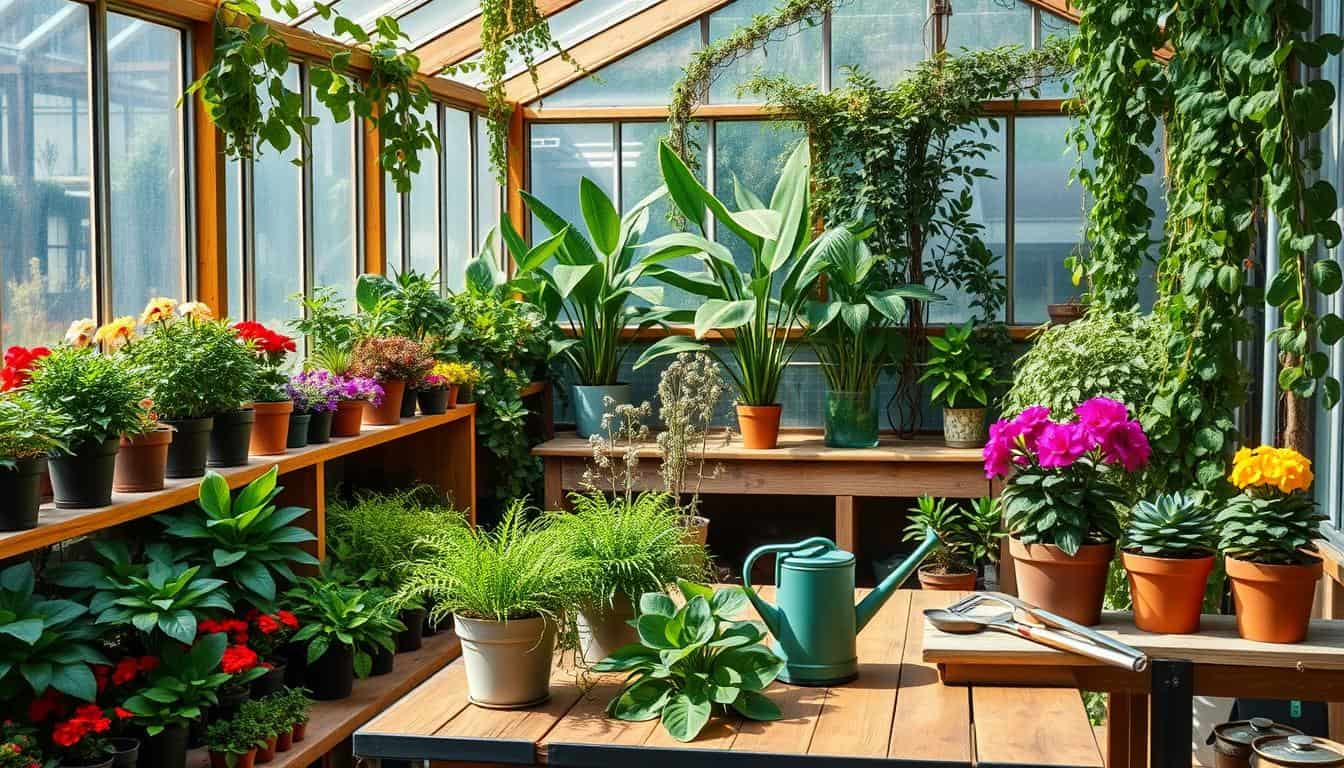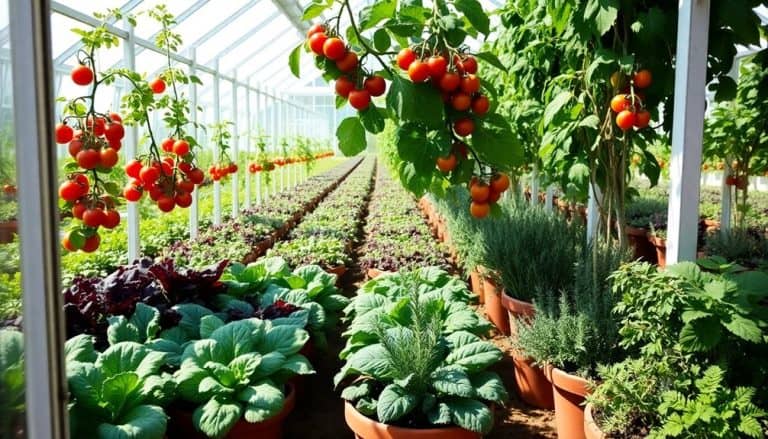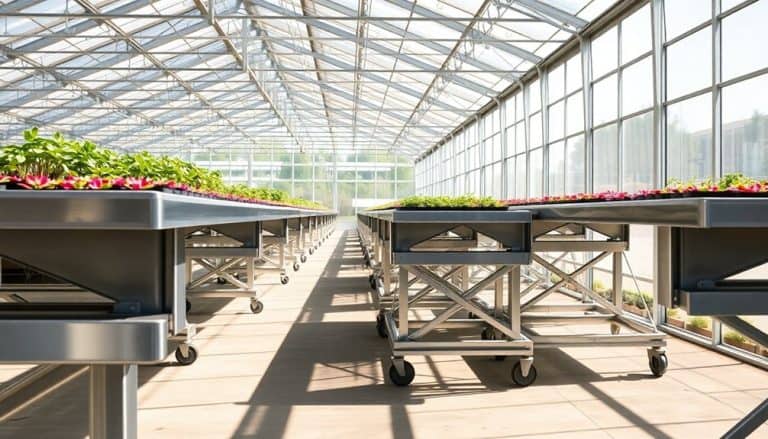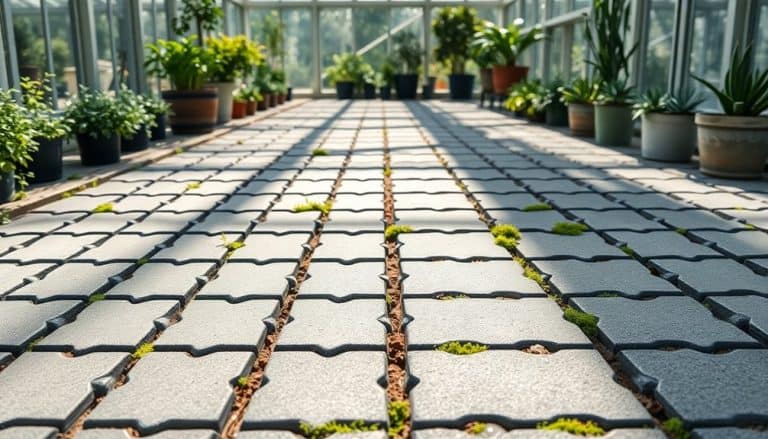This website contains affiliate links. Some products are gifted by the brand to test. As an Amazon Associate, I earn from qualifying purchases. The content on this website was created with the help of AI.
Radishes can grow from seed to harvest in just 18 days in a greenhouse. This quick growth shows the amazing potential of greenhouse gardening. It allows for year-round growing and perfect conditions for plants.
Greenhouse gardening lets you grow many plants all year long. You can grow fresh veggies and bright flowers in this controlled space. It’s perfect for trying new methods and growing different plant types.
In 2010, a group created a Best Management Practices (BMP) Guide for greenhouse crops. The group included the Massachusetts Farm Bureau and other organizations. This guide helps make farming profitable and eco-friendly.
Experts and growers helped create the Greenhouse BMP Manual. It covers important topics like nutrient management and water quality. The manual also includes info on composting and saving energy.
These practices give greenhouse growers the latest advice for their work. They help create the best growing conditions all year round.
Key Takeaways
- Radishes can grow from seed to harvest in 18 days in a greenhouse
- Greenhouse gardening enables year-round cultivation of diverse plants
- Best Management Practices (BMP) Guide supports sustainable greenhouse production
- The Greenhouse BMP Manual covers crucial aspects like nutrient management and energy conservation
- Controlled environment in greenhouses allows for experimentation with various gardening techniques
Essential Planning and Setup for Greenhouse Success
Planning is key for optimal growing conditions in a greenhouse. We’ll explore crucial aspects of setup, types, and layout. This will help you create an ideal environment for your plants.
Choosing the Right Greenhouse Type
Greenhouses come in various sizes, shapes, and materials. Glass structures offer durability, while polycarbonate options are affordable and long-lasting.
Polycarbonate greenhouses typically last 15-20 years with a 10-year warranty. Your space and budget should guide your greenhouse type selection.
Strategic Location and Layout Planning
A proper greenhouse layout is vital for plant health. Position it where there’s plenty of sunlight to reduce the need for extra lighting.
Semi-sheltered areas offer protection against strong winds. Check local zoning rules, as freestanding greenhouses often need 10-15 ft setbacks.
Basic Equipment and Tools Needed
Equip your greenhouse with essential tools for success. Circulation fans keep air moving 24/7, while heating systems maintain warmth.
Gas heaters are 80% efficient, and electric heaters offer 100% efficiency. T5 fluorescent grow lights are popular and cost-effective for supplemental lighting.
| Equipment | Purpose | Efficiency |
|---|---|---|
| Circulation Fans | Air Movement | 24/7 Operation |
| Gas Heaters | Heating | 80% Efficient |
| Electric Heaters | Heating | 100% Efficient |
| T5 Fluorescent Lights | Supplemental Lighting | Cost-Effective |
Best Practices for Greenhouse Gardening
Greenhouse gardening allows for year-round growing. Let’s explore space-maximizing techniques and plant selection for continuous harvests. You’ll discover how to create a thriving garden in any season.
Year-Round Growing Techniques
Planning is crucial for year-round greenhouse gardening. Start with cold-tolerant crops like kale and lettuce in fall. Switch to heat-loving plants such as tomatoes when winter approaches.
This rotation ensures fresh produce throughout the year. You’ll enjoy a variety of vegetables, regardless of the season.
Space Optimization Strategies
Vertical gardening helps maximize limited greenhouse space. Use trellises for climbing plants and tiered shelving systems. This approach allows you to grow more in less area.
Time stacking is another useful technique. Plant quick-growing crops between slower-maturing ones. This method ensures efficient use of your greenhouse space.
Plant Selection and Rotation
Choosing the right plants is key to successful greenhouse gardening. Rotate crops to maintain soil health and prevent pest buildup. Easy-to-grow options include basil, spinach, and cucumbers.
These reliable choices are great for beginners. They provide a good starting point for your greenhouse garden.
| Season | Recommended Crops | Growing Tips |
|---|---|---|
| Spring | Lettuce, Spinach, Peas | Start seeds early indoors |
| Summer | Tomatoes, Peppers, Cucumbers | Provide ample ventilation |
| Fall | Kale, Green Onions, Parsley | Monitor temperature closely |
| Winter | Microgreens, Herbs, Leeks | Use grow lights for extra warmth |
These best practices create a thriving environment for diverse crops. Careful plant selection and rotation strategies ensure continuous harvests. You’ll enjoy fresh, homegrown produce all year long.
Greenhouse Temperature Control and Management
Proper greenhouse temperature control is key for healthy plant growth. We’ll cover ideal temperatures, heating options, and cooling methods for your plants’ perfect environment.
Optimal Temperature Ranges for Different Plants
Plants need specific temperatures to thrive. Most plants grow best between 68°F and 77°F. This range allows for efficient photosynthesis.
Here’s a breakdown of ideal temperatures for various plant types:
| Plant Type | Ideal Temperature Range (°F) |
|---|---|
| Tropical Plants | 75-85 |
| Cacti and Succulents | 60-70 |
| Tomatoes and Peppers | 65-75 |
| Orchids | 60-70 |
| Herbs | 50-70 |
Heating Solutions for Cold Weather
Greenhouse heating is crucial during cold months. Gas or electric heaters are common choices. The Direct Vent Empire gas heater uses outside air for safe combustion.
For smaller spaces, portable heaters like the Dayton 120-Volt work well. It provides 1,500 watts of heat with built-in safety features.
Cooling Methods for Summer Months
Summer requires effective greenhouse cooling. Shade cloths can block 30-50% of light in hot months. The Lockknit shade fabric kit can lower temperatures by up to 15°F.
Evaporative cooling systems, like the 2800 CFM Evaporative Cooler, cool incoming air by 15°F to 30°F. HAF fans help spread cool air evenly for proper ventilation.
Using these heating and cooling methods ensures ideal temperatures year-round. This approach promotes optimal plant growth in greenhouses.
Professional Irrigation Techniques for Greenhouse Plants
Efficient greenhouse irrigation is vital for plant growth success. Professional watering techniques can boost growth rates by 25%. They also reduce water usage by 30% compared to manual methods.
Drip irrigation is a top choice for greenhouse watering. It delivers water directly to plant roots. This system cuts water waste by 50% compared to overhead watering.
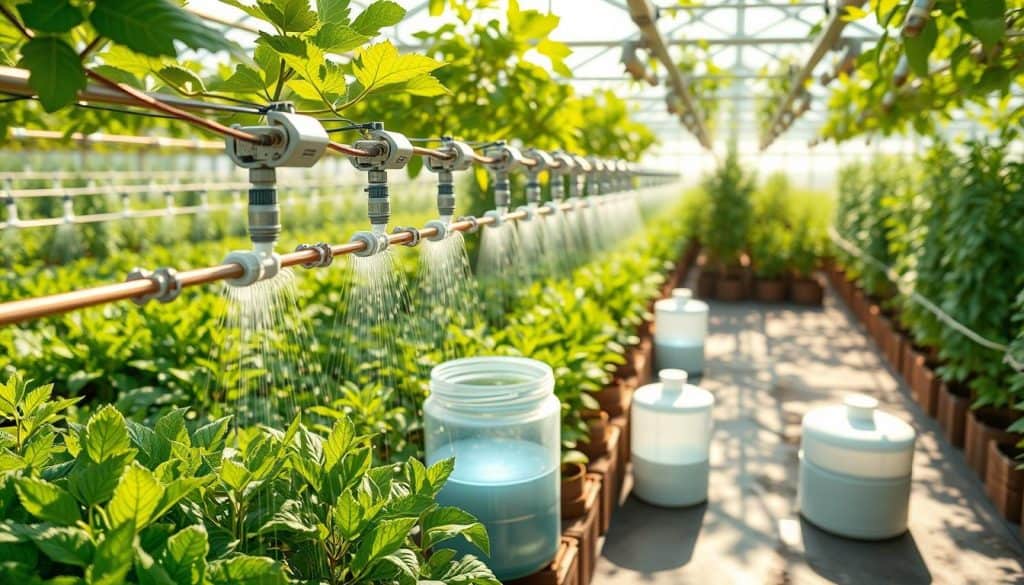
Grouping plants with similar needs is another smart technique. This strategy can reduce water waste by 20% in greenhouses. Capillary mats offer sub-irrigation for smaller plants.
Capillary mats decrease water waste by 15%. They also lower risks of rot and fungal diseases. Installing a collection tank for recycled water maximizes conservation.
A recycled water system can slash water bills by 40%. It promotes sustainable practices when connected to drip systems and rainwater harvesting.
| Irrigation Method | Water Savings | Benefits |
|---|---|---|
| Drip Irrigation | Up to 50% | Targeted root delivery, reduced evaporation |
| Plant Grouping | Up to 20% | Efficient water distribution, easier management |
| Capillary Mats | Up to 15% | Prevents overwatering, reduces disease risk |
| Recycled Water System | Up to 40% | Lower water bills, sustainable practice |
These professional irrigation techniques ensure optimal plant health in greenhouses. They also conserve water effectively. Tailor your watering approach to your crops for best results.
Soil Preparation and Management
Proper soil prep is key for greenhouse plant success. We suggest a mix of 60% loam soil, 30% compost, and 10% potting mix. This blend ensures good moisture retention and drainage for healthy roots.
Soil Mixing Guidelines
Use loam as your base for greenhouse soil. It offers a great mix of sand, silt, and clay. Add compost to boost nutrients and improve soil structure.
Include potting mix items like peat moss or perlite. These help with air flow and water retention in your soil.
Nutrient Management
Good nutrient management is vital for thriving plants. Add organic matter often to replace nutrients that deplete quickly in greenhouses. Test your soil every three months.
Adjust your fertilizer plan based on these tests. This keeps nutrient levels just right for your crops.
pH Balance Maintenance
The right pH balance helps plants absorb nutrients. Aim for a pH between 6 and 7 in your greenhouse soil. Test regularly to make needed changes.
Use dolomitic lime to raise pH if it’s too low. Add sulfur to lower it if it’s too high. Proper pH lets plants use all available nutrients.
| Soil Component | Percentage | Purpose |
|---|---|---|
| Loam Soil | 60% | Provides balance of sand, silt, and clay |
| Compost | 30% | Adds nutrients and improves soil structure |
| Potting Mix | 10% | Enhances aeration and water retention |
Effective Ventilation and Humidity Control
Greenhouse ventilation and humidity control are vital for healthy plants. Let’s explore strategies to maintain optimal conditions in your greenhouse.
Air circulation prevents fungal diseases and promotes plant health. Install roof vents, side vents, and fans for proper airflow. Aim for humidity levels of 60-75% at night and 80-90% during the day.
Boost moisture by placing pebble trays under plants. To reduce humidity, space plants properly and use well-drained floors.
Temperature greatly affects humidity. Warm air holds more moisture than cool air. As temperature rises, air can hold more water, lowering relative humidity.
- Use sling psychrometers for accurate humidity measurements
- Implement bottom heat to improve air circulation within plant canopies
- Consider anti-drip plastic to help reduce humidity levels
Ventilation systems include natural, forced-air, and evaporative cooling options. Choose based on greenhouse size and local climate. Good ventilation prevents fungal growth and maintains ideal humidity.
Natural and Artificial Lighting Strategies
Greenhouse lighting is vital for plant growth. We’ll explore ways to use natural light and artificial grow lights effectively.
Maximizing Natural Light
Position your greenhouse for maximum sunlight exposure. Use reflective surfaces to boost light distribution. Natural light offers a full spectrum, promoting optimal plant growth.
Supplemental Lighting Options
Artificial grow lights are crucial when natural light is scarce. LED lights are energy-efficient and versatile. Fluorescent lights suit smaller setups, while HID lights work for larger operations.
Seasonal Light Management
Adapt your lighting strategy with the changing seasons. Add artificial lights in winter to maintain growth. Use shading techniques in summer to prevent overexposure.
| Light Type | Wavelength (nm) | Best Use |
|---|---|---|
| Red Light | 620-700 | Flowering, fruiting |
| Blue Light | 400-520 | Vegetative growth |
| Full Spectrum | 400-700 | Overall plant development |
Mix natural and artificial light for year-round plant growth in greenhouses. Use photometers to measure light levels. This ensures plants get enough illumination.
Organic Pest Management Solutions
Greenhouse pest control is vital for plant health. We use organic techniques to protect our greenhouse without harmful chemicals. Our approach combines biological controls, physical barriers, and cultural practices.
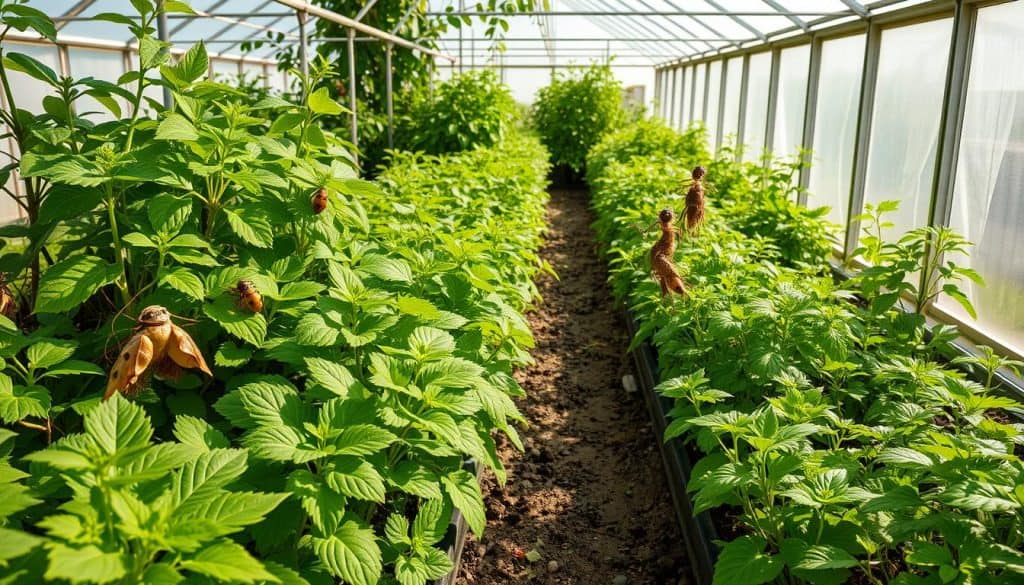
Prevention is our top priority. We inspect plants regularly to catch infestations early. Proper sanitation helps minimize pest outbreaks.
When issues arise, we use natural solutions. Beneficial insects are key to our strategy. Ladybugs fight aphids, while nematodes target soil-dwelling pests.
We also use organic sprays made from chili, garlic, and soap. These natural remedies help deter unwanted visitors effectively.
- Diatomaceous earth for crawling insects
- Sticky traps for flying pests
- Yellow plates with olive oil to attract and trap small insects
- Wormwood as a natural repellent
Our pest management aligns with plant life cycles. We’re extra careful during seeding, fruiting, and plant death stages. These periods often see more pest activity.
By understanding these patterns, we apply targeted solutions effectively. This creates a thriving greenhouse ecosystem. Our plants grow strong and healthy, free from harmful pesticides.
Our organic approach protects crops and preserves the greenhouse’s delicate balance. It’s a win-win for plants and the environment.
Seasonal Maintenance and Care Guidelines
Proper greenhouse maintenance is vital for success all year. Our seasonal care approach helps plants thrive in every season. In spring, we increase airflow by opening vents and adding fans.
Summer brings unique challenges. We recommend regular pest control checks to protect your garden. It’s also ideal for applying fertilizers to support high-growth periods.
As fall nears, we focus on insulation. Using bubble wrap can extend your growing season by keeping the greenhouse warm.
Winter is perfect for planning and reflection. We review past successes and plan crop rotations. It’s crucial to ensure heating systems run efficiently for winter care.
Regular cleaning is key. Clean the exterior twice yearly, in spring and fall. This maximizes light transmission for your plants.
Follow these tips for a thriving greenhouse environment. Regular inspections and timely adjustments are crucial. Consistent care is the cornerstone of successful greenhouse gardening.

